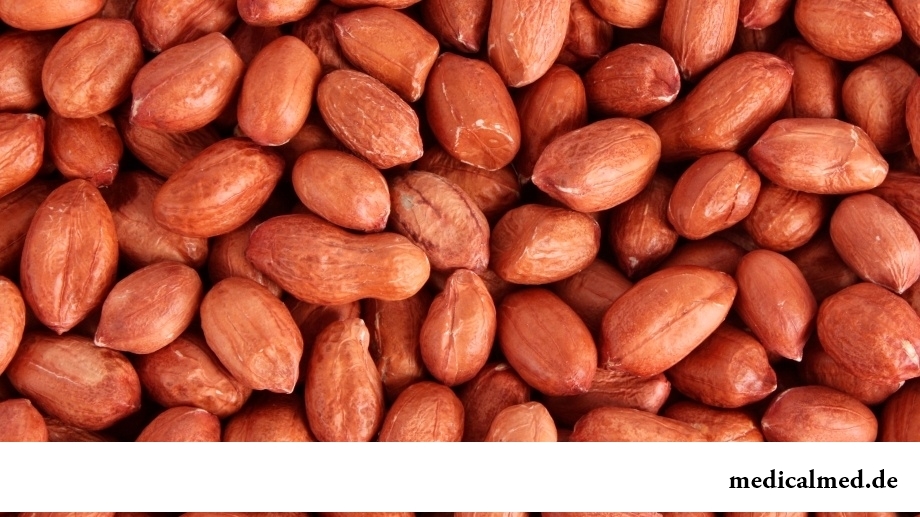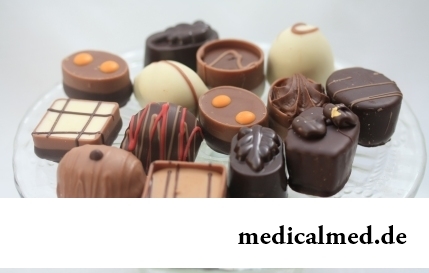





Peanut
Useful properties of a peanut
The peanut does not belong to nuts as it is usually considered to be, its "nutlets" are fruits of the annual bean plant growing in a warm and humid climate. The set of substances, useful to an organism, is its part. So, the peanut contains high-quality fats which make nearly a half of its weight. It also causes the high caloric content of a peanut – 551 kcal on 100 g. Besides the proteins entering it easily are acquired thanks to what the peanut is often recommended to eat at serious illnesses and severe exhaustion.

Also the peanut contains various vitamins, most of all RR vitamin, influencing exchange processes and a nervous system. For ensuring daily need of an organism for this vitamin it is enough to eat 100 g of nuts a day. Also vitamin C and insignificant amount of B1 and B2 vitamins are chemical composition of a peanut.
From micro and the macrocells which are in nuts, the leading place is taken by potassium. Therefore the peanut is useful to prevention of development of heart diseases, improvement of physical activity, and also to regulation of water and acid-base balance in an organism. Also in it there is a lot of calcium, phosphorus, iron, magnesium and sodium.
In addition, still useful properties of a peanut give the antioxidants which are in it in a large number – polyphenols which protect living cells of an organism from harmful effects of free radicals, thereby interfering with aging.
Based on the conducted peanut researches, it is put in one row with a wild strawberry and blackberry on ability to influence aging processes, and also for prevention of formation of malignant tumors and diseases of cardiovascular system.
Also the peanut is useful at gastritises and a peptic ulcer, contributes to normalization of processes of a hemopoiesis and improves memory.
Use
The peanut is eaten both crude, and fried. In order that it did not lose the useful properties, it is fried on small fire without vegetable oils.
As a peanut – a high-calorific product (caloric content of a peanut makes 551 Kcal on 100 g), it is not recommended to be eaten in the evening to avoid excess weight. For a nutritious and vitamin-rich breakfast it is possible to use peanut paste. It can be bought or prepared independently for what dry roasted peanuts are mixed in the food processor with a small amount of salt. For giving of taste it is possible to add a little honey to paste.

It is also useful to use peanut butter which improves taste and nutritiousness of salads and sauces. Oil is recommended to use at diabetes and diseases of cardiovascular system for decrease in level of cholesterol, normalization of arterial pressure and increase in elasticity of blood vessels. Outwardly oil from a peanut can be applied as bactericidal and wound healing means at treatment of eczemas, diapyetic wounds and herpes.
Contraindications to use of a peanut
Despite all advantage which the peanut can bring it needs to be included in the diet with care. So, in large numbers the peanut is harmful and can slow down approach of a reproductive maturity of an organism, and also lead to disturbances of cardiovascular system and function of a liver as rather poisonous erucic acid which, besides, is practically not removed from an organism is its chemical composition.
Also, because of the high caloric content of a peanut it is not recommended to be eaten at disturbances of exchange processes and excessive weight. Besides, the peanut is harmful to the people inclined to allergic diseases and abuse of it can bring to disturbances of the alimentary system, abdominal pains and hypostases of an oral cavity.
In Great Britain there is a law according to which the surgeon can refuse to do to the patient operation if he smokes or has excess weight. The person has to refuse addictions, and then, perhaps, he will not need an operative measure.

The summer of this year in Russia was very ambiguous. Regions suffered from a merciless heat, from pouring rains, from times...
Section: Articles about health
Each person supports all life a SARS about 200 times. The peak of incidence falls on cold season, but it is possible to get sick with a temperature and a pharyngalgia, and sometimes and very possibly, even during a heat. The reasons for development of catarrhal diseases exists множество:...
Section: Articles about health
Heart disease and blood vessels lead to disturbance of blood supply of bodies and fabrics that involves failures in their work, deterioration in health of the person, decrease in its working capacity and standard of living. Annually more than 17 million inhabitants of our planet perish from pathologies such....
Section: Articles about health
Small appetite at the child – the complaint which pediatricians should hear practically from each mother. Most often it is carried to разр...
Section: Articles about health
Beauty shop – the place which is associated only with positive emotions: joy, pleasure, relaxation. However visit of salon where work with biological material of clients, not always harmlessly is conducted. Today it is known Bol...
Section: Articles about health
Residents of big cities quite often have a disease which is known as the syndrome of chronic fatigue (SCF) today. This illness affects the people belonging to various social and demographic groups and living on all continents. Most of all SHU are subject women aged from 25 up to 45 years. Statistically, the number of cases fluctuates in the different countries from 10 to 37 people on 100 thousand, but specialists believe that these figures are significantly underestimated as people, страдающ...
Section: Articles about health
Practically each person is familiar with the annoying, pulling, unscrewing pains caused by overcooling of muscles of a back. In некото...
Section: Articles about health
So, you resolved to lose weight. And now you try to understand what to begin with: from exercise stresses or a diet? And how to make that process of weight loss did not give you an inconvenience, and, on the contrary, brought joy?...
Section: Slideshow
Work of a brain is extremely complex and in many respects is not studied yet. It is confirmed also by the features of thought processes which are shown when the person sleeps. Let's tell about some of them....
Section: Articles about health
At this plant there are a lot of names: tuberiferous sunflower, Jerusalem artichoke, solar root, earth pear. Contrary to spread...
Section: Articles about health
Within several decades of our compatriots convinced that the use of butter nasty affects a condition of coronary vessels. As a result the reputation of a product was impaired thoroughly a little, and many almost ceased to include...
Section: Articles about health
Statistically, in Russia about 34% of citizens smoke. Most of consumers of tobacco has problems with health sooner or later. Not only smokers, but also their relatives suffer. Besides, cigarettes are expensive, and need of their acquisition goes a heavy burden on the budget of thousands of Russian families. Many people dream to refuse harmful tendency, but everyone manages to make it not: nicotine addiction is affectionate and to get rid of it not easy....
Section: Articles about health
Statistically, at the address to doctors seven of each ten patients complain of a headache. Actually people, periodically...
Section: Articles about health
The thought that the mass of their body is too big at least once in life visits from 80 to 95% of women. Many women are so obsessed with this idea that constantly try all new and new ways of weight reduction. Considerable part of these method...
Section: Articles about health
Memory is an ability of the central nervous system to fix, keep and as necessary to reproduce information on knowledge or skills received by the person or an animal during life. The mechanism of this process is up to the end not studied....
Section: Articles about health
Visit of doctors – business not the most pleasant, and many people do not hurry to undergo necessary planned inspections. Such behavior...
Section: Articles about health
Childbirth is the most important event in life of each woman. We are women we give birth to the new little man on this light. Now the tendency to that was outlined, as men want to participate in labor too. But there is a question and whether it is worth allowing the husband...
Section: Articles about health
You heard that laughter prolongs life? Researchers did not manage to establish longevity direct link with sincere fun yet, but several facts confirming beneficial influence of risibility on the state of health are clinically proved....
Section: Articles about health
The state of health of the person depends on many factors. One of the most important is the constant but which is not exhausting, motive...
Section: Articles about health
Tea is loved and use almost everything. This drink has tonic properties, contains the tannins capable to suppress activity of causative organisms. Recently great popularity was gained by teas with vegetable additives. Лечеб...
Section: Articles about health
Eyes – one of the most vulnerable areas on a face therefore age changes concern them first of all. Whether it is possible to keep look youth for many years and what procedures are offered for achievement of this purpose by cosmetologists? And maybe, the only option of rejuvenation is surgery – a blepharoplasty? Let's try to understand this question....
Section: Articles about health
The problem of diagnosis was and remains to one of the most important in medicine. From that, the reason недо will be how precisely defined...
Section: Articles about health
What woman does not dream of a beautiful and thick hair? While physicians developed difficult schemes on hair transplant, in the industry of hairdresser's art a few years ago there was a sensation – methods of hair extension appeared. It would seem, dreams came true...
Section: Articles about health
Urogenital candidiasis (milkwoman) – a fungal infection which annoys unpleasant feelings in the field of generative organs, being followed by white curdled allocations, an itch, discomfort during an urination, pain. She is called by Candida fungus – the opportunistic organism living on mucous membranes of an organism....
Section: Articles about health
Among a set of the perfumery and cosmetic goods which are released today the special group is made by the means containing anti-bacterial...
Section: Articles about health
Tick-borne encephalitis – one of the most dangerous viral diseases which causative agents transfer and is given to people by ixodic mites. These are the small blood-sicking insects living in the considerable territory of our country. The person bitten by a tick can catch...
Section: Articles about health
It is known that the person for 80% consists of water which participates in all processes of an organism. The person loses liquid daily – as a result of sweating, breath, an urination, and its insufficient completion due to various reasons can lead to dehydration of varying severity. Dehydration (dehydration) occurs already in case of loss of liquid in number of 1% of body weight and can result both in easy thirst, and by the death. In time to notice signs обезвож...
Section: Articles about health
